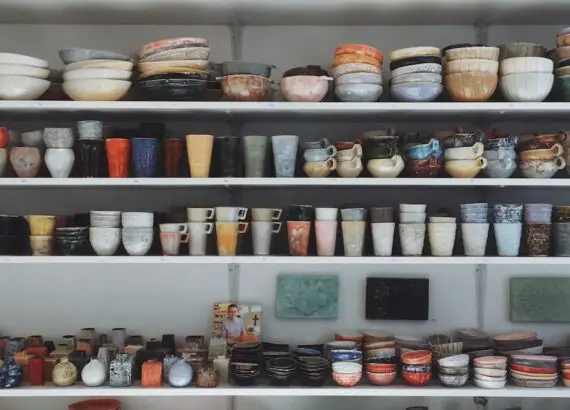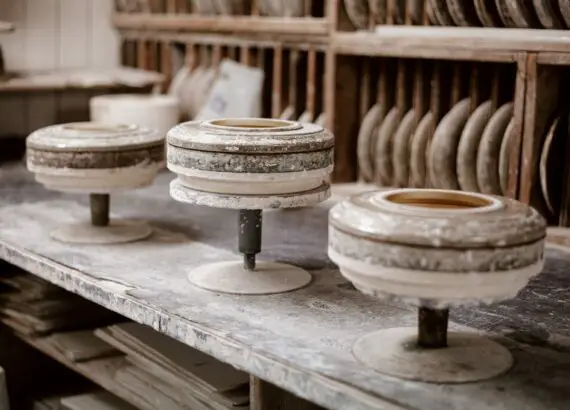How Does The Pottery Wheel Work? (11 important questions)

Since the concept of civilization came into being, human interaction and communal living have necessitated the existence of utensils and wares meant for home use.
As the first civilized communities came to be, so was a need to manufacture wares to be used in the homes. Ceramic or porcelain wares were in vogue, and early craftsmen were tasked to achieve this.
By 4000BC, the manufacturing of ceramic wares was done in a slow, tiresome manner. By coiling the plastic clay on a flat surface, these craftsmen worked on the first porcelain wares.
Table of Contents
How Does Pottery Wheel Work?
A spinning circular table is where the pottery is done. A splash pan runs around the outside of the wheel, catching water and clay as it rotates. The wheel is approximately waist height and is mounted on a frame. To work with the clay, you sit in front of the wheel and lean forward. As long as the foot pedal is pressed, the wheel will spin indefinitely. The potter is sculpting the clay into the sculpture he wants to produce while it spins. The rotation can be electrically controlled or with a pedal.
How Did Old Pottery Wheels Work?
Old Pottery wheels were manually rotated, with a stomp of the user’s feet to start the process. This is the most straightforward method. The potter swings his foot across the spinning hub from one side to the other, forcing it to spin in one direction. Another approach was to have a crankshaft with a lever that translates up and down motion into rotational motion, which was devised at an unknown period. Other methods for spinning a potter’s wheel included putting a stick in a hole at the top and twisting it, or just spinning it by hand.
What are the Three Main Work Areas of the Pottery Wheel?
A pottery wheel has a motor system that spins the wheel. The motor is one of the most important components of the wheel since it drives it. When inspecting motors, pay attention to the number of revolutions per minute (RPMs) the motor can produce.
The spinning element of the Electric Wheel that forms the clay is known as the wheel head. When it comes to wheel heads, size is the most important factor to consider. Bigger diameter wheel heads can handle higher clay weights, allowing you to build larger pots, bowls, and other shapes. The wheel is the round surface where the pottery is done. The foot pedal controls the spin. For this reason, these are the three main work areas of the pottery wheel.
What is Pottery Wheel Made of?
Modern versions of the pottery wheel are made with varying materials. It is made with wood, metal, or plastic, and some are made with a combination of all three. It is also worthy to note that pottery wheels of the 16th century vary very much from those of the 19th century.
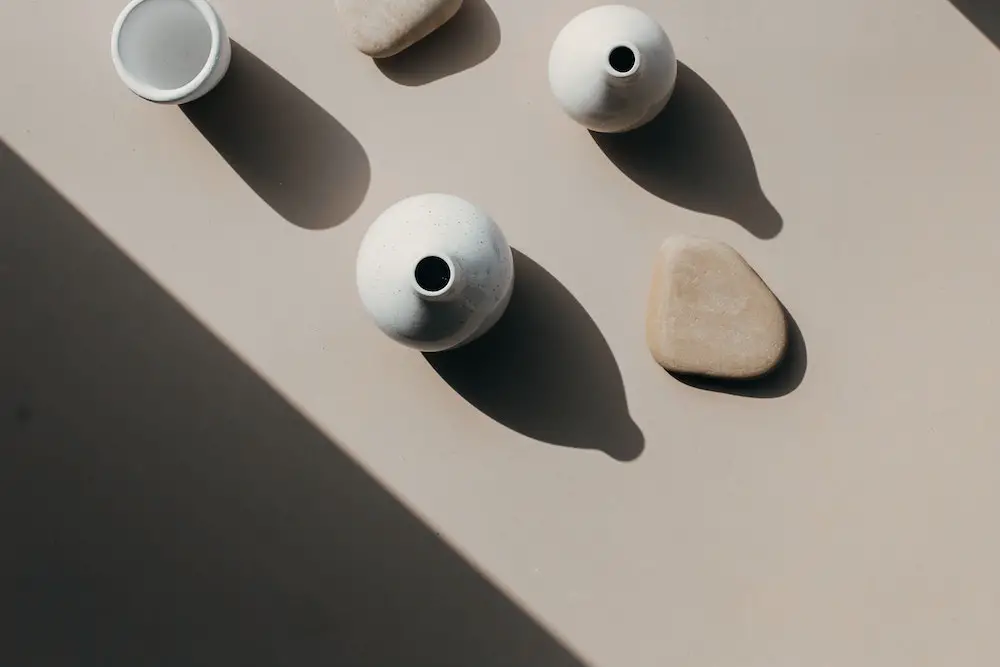
In the 16th century, the pottery wheel was made with wood and greased leather, while in the 19th century, it was made out of Iron, steel rods, and greased metal ball bearings.
The conceptual design of the pottery wheels that are commonly used in the 21st century has been altered entirely but still has the same principle.
Some modern wheels are still like the kick wheels of the 19th century, while electrical wheels come with motors and pedals to make the wheel rotate.
What are the Parts of the Pottery Wheel?
Over the centuries, many parts have been added to the pottery wheel. The designs may vary with the designers, but the essential elements have remained the same. They are:
1. The Throw Surface
This is also known as the head or spinning table. In the much older versions, it was referred to as the bat. The throw surface is the disk or wheel on which the potter works and fashions the clay.
2. The Splash Pan
The splash pan is a protective circular frame that goes around the throw surface or bat. This pan serves to prevent mud or water from splashing from the bat to the work area.
3. The Shaft
The shaft is the part of the pottery wheel that transmits momentum from the flywheel to the head (bat). The shaft is a sturdy iron that supports the throw table in the middle and is allowed to spin, which turns the head.
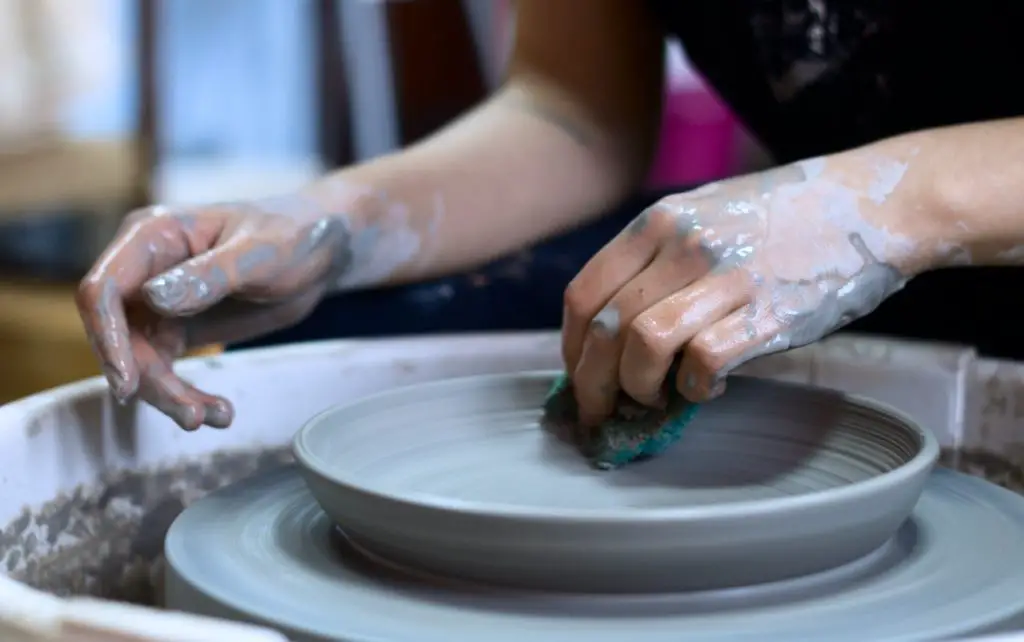
4. The Pedal / Flywheel
This is the mechanism used to turn the throwing surface. The electrical pottery wheel that we have today uses a pedal to control the spinning. Meanwhile, only a few old models and some rare modern ones were made with the flywheel.
In moderns with the flywheel, the flywheel is kicked repeatedly until it gains speed and rotates. When the speed drops and is needed again, the flywheel is kicked again.
5. The Support Table
The support table works to support the shaft and protect it so as not to allow it to bend under the weight of the throw table.
6. The Seat
Not all pottery wheels come with a seat. While the ones that come with a chair are super convenient, you could always use a low stool if you don’t have a seat.
What is a Pottery Wheel Bat?
A pottery wheel bat is a thin slab of wood, plaster, or plastic that is used to support ceramic shapes while they are being thrown. There’s no need to physically handle your clay piece and risk altering its shape because the bat piece may be lifted off the wheel head. A batterboard is another name for it.
What are Pins on a Pottery Wheel?
Many varieties of bats are attached to potters wheels using pins. They are also called Bat pins. These Bat pins are constructed of marine-grade stainless steel that will not rust or react with your aluminum wheel head. Short pins are used on smaller type wheels, whereas long pins are used on bigger wheel heads.
In What Direction Does A Spinning Wheel Spin?
When it was invented, the pottery wheel was made to rotate counterclockwise. However, with the giant leaps in technology nowadays, the pottery wheel can spin in both directions, depending on your most dominant hand.
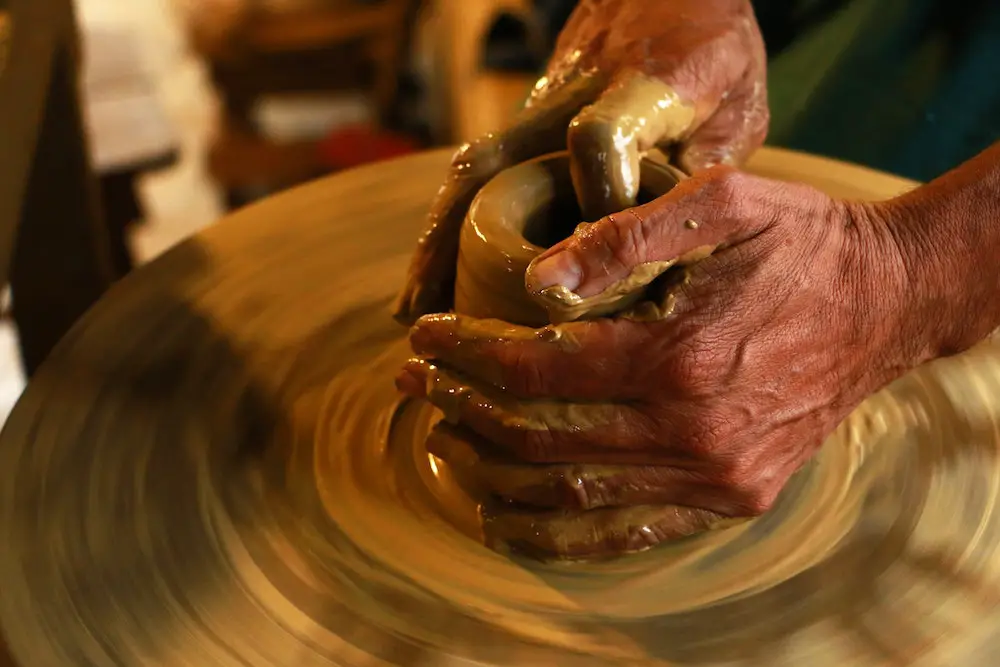
With right-handed potters, the spinning wheel should rotate anti-clockwise with their left hand smoothening the inside and their right hand on the out.
While with left-handed people, the spinning wheel should turn clockwise with their hands vice versa.
How Fast Should A Pottery Wheel Spin?
Typically, a pottery wheel can revolve between 240 to 300rpm (revolution per minute).
However, the most recommended speed lies between 100 and 140rpm. Some experts prefer working at lower speeds to give them more control.
When you throw the clay on the throwing surface, the spin should be about 100- 150 rpm. If too high, the spinning force will ruin the clay work. If too slow, the clay does not form well. In the process of using your rib, the speed should be between 30- 40rpm
Leaps in technology have guaranteed that potters’ workload is reduced when working their craft. Despite the difference in models, it is possible to master the wheel.
How Much Electricity Does a Pottery Wheel Use?
The amount of amps that the wheel pulls is determined by the amount of work being done on it at any particular moment. This can be anything from 1 to 15 amps. As a result of all of this, the wattage would be between 120 and 1800, as wattage is defined as volts times amps. The type of potter’s wheel can also determine the electricity consumption level. What counts is the wheel’s ability to withstand the strain, which is commonly measured in centering capacity. This is due to the fact that five 1/2hp wheels will respond differently depending on how the wheel is built and what sort of controller is used.
How Big is a Pottery Wheel?
Wheel heads can come in different forms and sizes. The most common are flat, circular, metal surfaces with 8″ to 14″ diameters in range. The size you choose will be primarily determined by the sorts of jobs you intend to do. You’ll need a larger wheelhead if you’re throwing particularly large pots, platters, and other clay pieces with wide bases.

